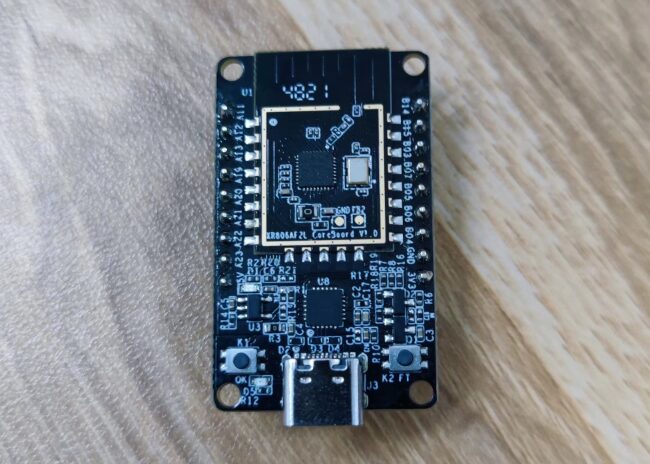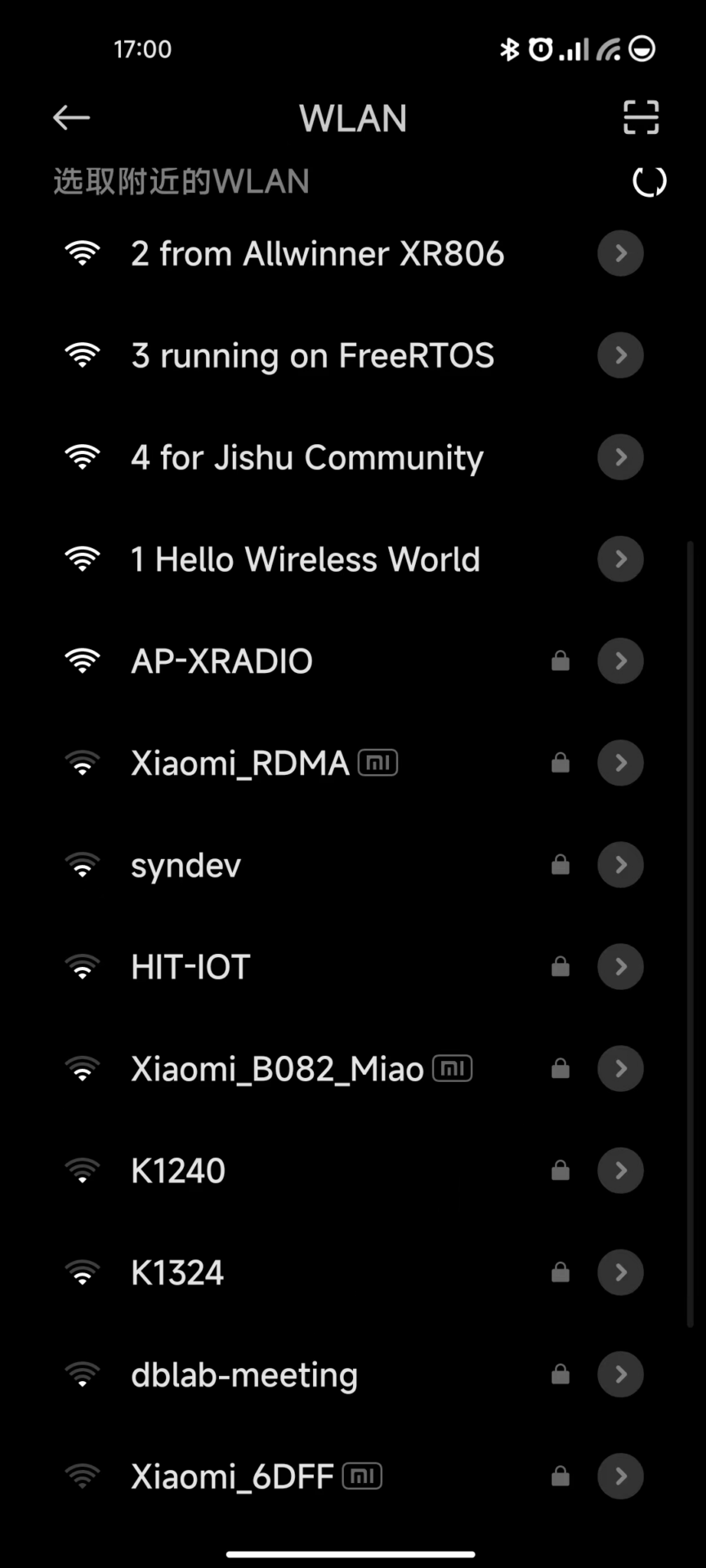This article is from the Jishu Community’s evaluation activity of the Allwinner XR806 development board. The author used the XR806 development board and the XR806 SDK based on FreeRTOS to implement custom sending of 802.11 Beacon frames, and conducted wireless packet capture analysis and scanning tests to verify the sending results of the frames.
Environment Configuration Process
The environment setup can refer to the official documentation for development environment setup (https://xr806.docs.aw-ol.com/rtos/env/). The development environment used in this test is Ubuntu 22.04. It should be noted that while downloading the ARM Toolchain, the link in the documentation is no longer available due to website updates. The current available download link is https://developer.arm.com/downloads/-/gnu-rm, where you can find the corresponding gcc-arm-none-eabi-8-2019-q3-update version for download.
After configuring the environment, select a Demo or Example for compilation. Under Ubuntu, the flashing tool used is the <span>phoenixMC</span> executable located in the tools directory of the SDK. The example flashing command is
./phoenixMC -c /dev/ttyUSB0 -i ../out/xr_system.img<span>-h</span>. After flashing, you can connect to the serial port to view the output. The console output may have misaligned line breaks, which need to be corrected. The serial tool used in this test is <span>picocom</span>, which requires converting the output <span>
</span> to <span>
</span>. The example connection command for the serial port ispicocom -b 115200 --imap lfcrlf /dev/ttyUSB0<span>upgrade</span> command, you can directly send the <span>upgrade</span> command. If not supported, you need to short-circuit the two contacts on the development board or use the flashing tool on Windows, selecting the hardware reset flashing mode.
Testing Process
By browsing the XR806 SDK, it can be found that the API int wlan_send_raw_frame(struct netif *netif, int type, uint8_t *buffer, int len); is provided in wlan.h. This API supports sending custom 802.11 frames, requiring only the network interface, frame type, data frame, and length. Inspired by esp32-80211-tx, in this test, custom Beacon frames are sent based on this API to create the illusion of multiple APs existing simultaneously. In the IBSS network architecture, the AP sends out a Beacon frame periodically to announce the existence of its 802.11 network. Passive scanning of Wi-Fi is also based on Beacon frames.
Constructing Beacon Using API
Further browsing the SDK reveals that the SDK provides the API <span>wlan_construct_beacon</span>, which simplifies our Beacon construction process. You only need to provide part of the fields for the beacon, such as SA, DA, BSSID, Channel, etc. The specific code is as follows:
#include <stdio.h>#include <string.h>#include "net/wlan/wlan.h"#include "net/wlan/wlan_defs.h"#include "net/wlan/wlan_ext_req.h"#include "net/wlan/wlan_frame.h"#include "common/framework/net_ctrl.h"#include "common/framework/platform_init.h"#include "lwip/inet.h"
define CMD_WLAN_NETIF wlan_netif_get(WLAN_MODE_NONE)
define BEACON_FRAME_LEN 256static uint8_t beacon_frame_buf[BEACON_FRAME_LEN];typedef struct { uint8_t *data; uint32_t len;} frame_data;static uint8_t beacon_addr[6];static char beacon_ssid[32];static uint32_t beacon_len;static frame_data beacon_frame;char *ssids[] = { "1 Hello Wireless World", "2 from Allwinner XR806", "3 running on FreeRTOS", "4 for Jishu Community" };uint8_t bssid[4][6] = { {0xba, 0xde, 0xaf, 0xfe, 0x00, 0x06}, {0xba, 0xde, 0xaf, 0xfe, 0x00, 0x07}, {0xba, 0xde, 0xaf, 0xfe, 0x00, 0x08}, {0xba, 0xde, 0xaf, 0xfe, 0x00, 0x09},};
#define TOTAL_LINES (sizeof(ssids) / sizeof(char *))
uint8_t line = 0;
static void beacon_frame_create(void){ wlan_ap_config_t config; memset(&config, 0, sizeof(config)); config.field = WLAN_AP_FIELD_SSID; if (wlan_ap_get_config(&config) != 0) { printf("get config failed\n"); return; } printf("ssid:%s,ssid_len: %d\n", ssids[line], strlen(ssids[line])); memcpy(beacon_ssid, ssids[line], strlen(ssids[line])); memcpy(beacon_addr, bssid[line], IEEE80211_ADDR_LEN); beacon_len = wlan_construct_beacon(beacon_frame_buf, BEACON_FRAME_LEN, beacon_addr, NULL, beacon_addr, (uint8_t *)beacon_ssid, strlen(ssids[line]), 1); if (++line >= TOTAL_LINES) { line = 0; } beacon_frame.data = beacon_frame_buf; beacon_frame.len = beacon_len; printf("beacon_len %d\n", beacon_len); int ret = 0; ret = wlan_send_raw_frame(CMD_WLAN_NETIF, IEEE80211_FC_STYPE_AUTH, beacon_frame.data, beacon_frame.len); printf("Send beacon frame: %d\n", ret);}
int main(void){ platform_init(); net_switch_mode(WLAN_MODE_HOSTAP); while(1) { OS_MSleep(100 / TOTAL_LINES); beacon_frame_create(); } return 0;}The basic logic of the code is as follows: First, predefine the SSIDs and their corresponding BSSIDs that need to be sent. Then, in the main function, initialize the AP mode first, and then send all the Beacons every 100ms. The content of the Beacon frame needs to be filled before sending the Beacon.
The testing effect is as follows. The SSID list used in the code is
"1 Hello Wireless World", "2 from Allwinner XR806", "3 running on FreeRTOS", "4 for Jishu Community"After powering up, the program starts, and you can see these AP information by scanning Wi-Fi with a mobile phone.

Among them, AP-XRADIO is the default AP name.
Constructing Beacon Without Using API
We can also directly fill in the content without using the relevant API. To demonstrate, we will migrate the implementation from the reference project here. The specific code is as follows:
#include <stdio.h>#include <string.h>#include "net/wlan/wlan.h"#include "net/wlan/wlan_defs.h"#include "net/wlan/wlan_ext_req.h"#include "net/wlan/wlan_frame.h"#include "common/framework/net_ctrl.h"#include "common/framework/platform_init.h"#include "lwip/inet.h"
define CMD_WLAN_NETIF wlan_netif_get(WLAN_MODE_NONE)
uint8_t beacon_raw[] = { 0x80, 0x00, // 0-1: Frame Control 0x00, 0x00, // 2-3: Duration 0xff, 0xff, 0xff, 0xff, 0xff, 0xff, // 4-9: Destination address (broadcast) 0xba, 0xde, 0xaf, 0xfe, 0x00, 0x06, // 10-15: Source address 0xba, 0xde, 0xaf, 0xfe, 0x00, 0x06, // 16-21: BSSID 0x00, 0x00, // 22-23: Sequence / fragment number 0x00, 0x01, 0x02, 0x03, 0x04, 0x05, 0x06, 0x07, // 24-31: Timestamp (GETS OVERWRITTEN TO 0 BY HARDWARE) 0x64, 0x00, // 32-33: Beacon interval 0x31, 0x04, // 34-35: Capability info 0x00, 0x00, /* FILL CONTENT HERE */ // 36-38: SSID parameter set, 0x00:length:content 0x01, 0x08, 0x82, 0x84, 0x8b, 0x96, 0x0c, 0x12, 0x18, 0x24, // 39-48: Supported rates 0x03, 0x01, 0x01, // 49-51: DS Parameter set, current channel 1 (= 0x01), 0x05, 0x04, 0x01, 0x02, 0x00, 0x00, // 52-57: Traffic Indication Map };
char *rick_ssids[] = { "01 Never gonna give you up", "02 Never gonna let you down", "03 Never gonna run around", "04 and desert you", "05 Never gonna make you cry", "06 Never gonna say goodbye", "07 Never gonna tell a lie", "08 and hurt you"};
#define BEACON_SSID_OFFSET 38#define SRCADDR_OFFSET 10#define BSSID_OFFSET 16#define SEQNUM_OFFSET 22#define TOTAL_LINES (sizeof(rick_ssids) / sizeof(char *))
int main(void){ platform_init(); net_switch_mode(WLAN_MODE_HOSTAP); uint8_t line = 0; // Keep track of beacon sequence numbers on a per-songline-basis uint16_t seqnum[TOTAL_LINES] = { 0 };
int ret = 0; while (1) { OS_MSleep(100 / TOTAL_LINES);
// Insert line of Rick Astley's "Never Gonna Give You Up" into beacon packet printf("%i %i %s\r\n", strlen(rick_ssids[line]), TOTAL_LINES, rick_ssids[line]); uint8_t beacon_rick[200]; memcpy(beacon_rick, beacon_raw, BEACON_SSID_OFFSET - 1); beacon_rick[BEACON_SSID_OFFSET - 1] = strlen(rick_ssids[line]); memcpy(&beacon_rick[BEACON_SSID_OFFSET], rick_ssids[line], strlen(rick_ssids[line])); memcpy(&beacon_rick[BEACON_SSID_OFFSET + strlen(rick_ssids[line])], &beacon_raw[BEACON_SSID_OFFSET], sizeof(beacon_raw) - BEACON_SSID_OFFSET);
// Last byte of source address / BSSID will be line number - emulate multiple APs broadcasting one song line each beacon_rick[SRCADDR_OFFSET + 5] = line; beacon_rick[BSSID_OFFSET + 5] = line;
// Update sequence number beacon_rick[SEQNUM_OFFSET] = (seqnum[line] & 0x0f) << 4; beacon_rick[SEQNUM_OFFSET + 1] = (seqnum[line] & 0xff0) >> 4; seqnum[line]++; if (seqnum[line] > 0xfff) seqnum[line] = 0;
// esp_wifi_80211_tx(WIFI_IF_AP, beacon_rick, sizeof(beacon_raw) + strlen(rick_ssids[line]), false); ret = wlan_send_raw_frame(CMD_WLAN_NETIF, IEEE80211_FC_STYPE_AUTH, beacon_rick, sizeof(beacon_raw) + strlen(rick_ssids[line])); printf("Send beacon: %d\n", ret); if (++line >= TOTAL_LINES) line = 0; } return 0;}The testing effect is as follows: Using the Netspot tool to obtain the wireless AP list

It can be seen that our defined SSID list (Never gonna give you up:)) is present along with the default AP name AP-XRADIO.
Wireless packet capture analysis of the XR806 Beacon shows the supported rates and other features.
Conclusion
This test sent custom Beacon frames. In fact, the XR806 also supports sending other types of frames, which can be further explored later. Finally, thanks to the Jishu Community and Allwinner Technology for the development board activity, as well as the community staff and friends for their questions and answers.
Copyright belongs to the original author. If there is any infringement, please contact for deletion.
END
关于安芯教育
安芯教育是聚焦AIoT(人工智能+物联网)的创新教育平台,提供从中小学到高等院校的贯通式AIoT教育解决方案。
安芯教育依托Arm技术,开发了ASC(Arm智能互联)课程及人才培养体系。已广泛应用于高等院校产学研合作及中小学STEM教育,致力于为学校和企业培养适应时代需求的智能互联领域人才。